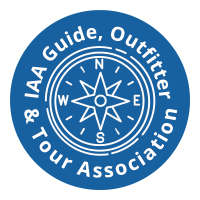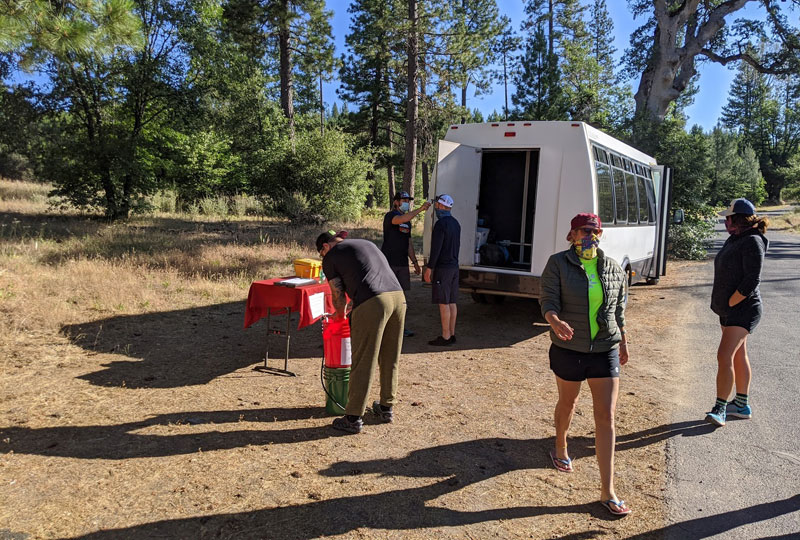You may still be trying to figure out which style of mask you prefer wearing for everyday life, let alone for an outdoor vacation like a river trip. While the best advice is to choose an option that you’re comfortable wearing for 30-plus minutes in any scenario, it’s also important to keep in mind that being outdoors in the summer heat will be a bit different than running to the grocery store.

With the help of feedback from our crew who’s been out in the field testing various face covering options, we’ve weighed in below with the pros and cons of some of the go-to designs out there so you can make the best decision for your individual needs before your rafting trip. You won’t be required to wear a mask in the raft (though you can choose to if you like), but some outfitters like OARS are expecting them to be worn at times when it may be impossible to physically distance from other guests or guides in camp like at the dinner line or while being transported to and from the river.
For this reason, we recommend packing at least two washable masks for any river trip. After each day, you can use a biodegradable soap to gently cleanse the mask and air-dry it while using your back-up face covering.
So, which style of mask is best for the outdoors? For most it will come down to personal preference, but here’s what to consider…
Pros and Cons: What’s the Best Style of Mask for River Trips?

1) Cotton mask with ear loops
A two- or three-layered cotton mask (potentially with a filter) is recommended by the CDC as a good go-to option since people can make their own, they’re fairly breathable and they also provide a better layer of protection against spreading COVID than some of the other options available.
Many of our guides are keeping a few of these on hand for trips into town, warehouse projects, or as a quick spare option, but on the river some guides have found they can be tough on the ears if you’re wearing them together with a hat and sunglasses with Chums. They also have a tendency to not fit as well as the double tie in back style.
As Lars Haarr, OARS Grand Canyon Manager points out, “Ill-fitting masks seem worse than not wearing one at all, as you end up touching your mask over and over again, or don’t want to wear it because it’s uncomfortable.”
2) Cotton mask with double tie in back
A cloth mask that ties behind your head often fits better around your face than the ear loop version, which makes it safer but also more comfortable and you’ll likely spend less time touching and adjusting it.
Many of our guides prefer the cotton mask with double tie in back because it acts a lot like a buff or gaiter-style face covering that can easily be pulled up and down when needed and can feel more airy and breathable than bandanas and buffs depending on fabric choices. Another pro that was shared by our crew is that they can be better for having conversations with people since bandanas and buffs have a tendency to slip down if you’re talking a lot.
If you don’t want to make your own, many retailers are now making cotton face coverings in both the ear loop and double tie in back styles, including several outdoor brands.

3) Neck Gaiter or Buff
The buffs or neck gaiter
style face coverings were designed with the outdoors in mind and many are quick-drying and offer moisture-wicking abilities and even UV protection. In addition to being able to easily pull them on and off, they can live around your neck so it’s handy whenever needed.
Along with bandanas, neck gaiters and buffs seem to be the most popular face covering option among our crews across the board.
“I think this is the go-to for trips, especially with guests, because we want them to have their face cover always at the ready,” says OARS Moab Manager, Seth Davis. “They also provide tons of sun protection and have a cooling effect when wet.”
One downside to the buff as a mask is that the fabrics are often synthetic, which experts have said are less effective in protecting you from airborne pathogens but will still reduce droplets from leaving your mouth and nose and slow the spread of COVID to others. You can double up the fabric to provide an added level of filtration. Or, look for a product like Buff Headwear’s Filter Mask, which includes replaceable filters that block 98% of airborne particulates.
4) Bandana
Like the neck gaiter or buff style face coverings, bandanas are easy to pull on and off and can stay around your neck. Like buffs and gaiters they can also act as a cooling device on hot days when soaked in water, but keep in mind that wet cotton doesn’t breath as well as some synthetic materials and can feel very heavy when worn. When bandanas are dry, however, they can feel more light and airy than many other options. Though some experts point out that since they’re open on the bottom they may be one of the least effective mask options. Still, the CDC says that any mask is better than no mask so it’s a viable, comfortable and readily-available option for many.
You could also consider a hybrid bandana option which combines the bandana/neck gaiter style with ear loops and is less open on the bottom. According to Davis, several guests have shown up to pre-trip meetings in Moab wearing this style of face covering and our crew felt it would be super functional and handy on river trips.

5) Disposable face masks
Disposable face masks better filter spray from coughs and sneezes than cloth options, but many are made with paper which might be problematic on a river trip with many opportunities for exposure to water. However, if you’re somebody who feels more comfortable wearing a new/fresh face covering daily, you can make them work for your trip. Consider bringing more than what you’ll need, however, in case one or two are exposed to water or damp clothes and can no longer function properly.
Aside from medical grade options like N95 respirator masks which should be reserved for frontline workers, no mask is perfect, but as long as you’re wearing one in public, you’re doing your part to help mitigate the spread of airborne pathogens and COVID.
*PLEASE NOTE THAT SOME OF THE LINKS ABOVE ARE AFFILIATE LINKS, AND OARS WILL EARN A SMALL COMMISSION IF YOU DECIDE TO MAKE A PURCHASE AFTER CLICKING THROUGH THE LINK.
The post How to Choose the Right Mask for River Trips appeared first on OARS.


Recent Comments